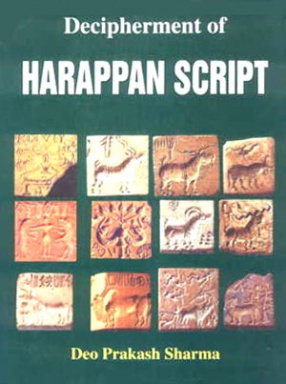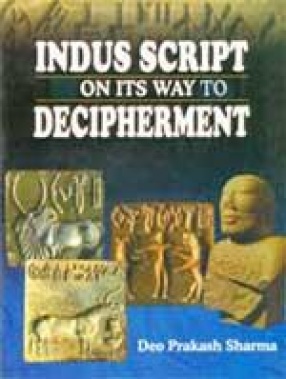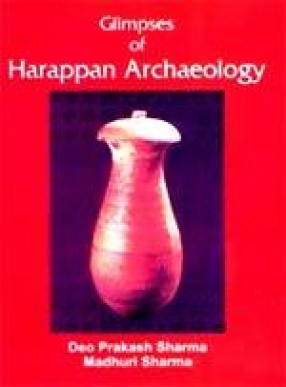
Deo Prakash Sharma

Showing all 11 books








The book Decipherment of Harappan Script is the result from an interest which the author developed in Harappan archaeology since last 24 years during his stay in Institute of Archaeology London and later on in National Museum, New Delhi where he was holding charge of Harappan material. Proto Dravidian and earliest Aryan were present in Harappan population. The author concluded Harappan script was Proto Brahmi and their languages were Proto-Dravidian Brahui and ...

This volume "Science and Metal Technology of Harappans' consist of twenty-one papers contributed by eminent scholars engaged in the systematic excavations and scientific study, research and analysis in the field of Harappan archaeology and allied sciences. Harappan culture is a Bronze Age Urban civilization. Though not the oldest, it is the first known civilization in the Indian subcontinent. It covers an area of two million square km. to date around 2700 ...

This book “EARLY BUDDHIST METAL IMAGES OF SOUTH ASIA†with Special Reference to Gupta-Vakataka Period is a Joint work of Mrs. Madhuri Sharma and D.P. Sharma, both Art Historians, Archaeologists and Museologists. This includes a chapter on origin of Metal images of South Asia, different stages of Gupta period Art and Catalogue data of rare metal images of Gupta-Vakataka period. The large number of Gupta period metal images are on display in the Museums of ...

This book "Indus Script on Its Way of Decipherment" is the result from an interest which the author developed in Harappan Archaeology since last 17 years during his stay at Institute of Archaeology London and later on in National Museum New Delhi where he is holding charge of Harappan material since the last 15 years. It was concluded Proto Dravidian and earliest Aryan were present in Harappan population. The author concluded Harappan script sign. This ...

This book "Newly Discovered copper Hoard, Weapons of South Asia" includes chapters on Copper Hoard collection in the National Museum, New Delhi, New Anthropomorphic figures from Ganga-Yamuna doab, New lugged shouldered axes from the Western Uttar Pradesh, New copper hoard in private collections of North India, Copper hoard implements in the National Museum, New Delhi, brief history of copper hoards from 1964 to 1986, Harappan and Ochre Coloured ...

The present book on Harappan terracotta documents rare figurines in the collection of the National Museum, New Delhi. Beginning with an introduction to the Harappan civilization. The next chapter introduces the Harappan terracottas, its technique of making, colour treatment and method of firing etc. The third chapter describes the male terracotta figurines and the fourth chapter is on female terracotta figurines. The study shows that the female figurines ...

The book "Palaeolithic Age" is the first book on Prehistoric Art and Archaeology of South Asia. The second book of this series is on Mesolithic-Neolithic and third book is Early Bronze and Iron Ages in South Asia. This volume Palaeolithic Age covers the sites of South Asia. Lower Palaeolithic Age begins in South Asia around 2 million years ago. Oldest tools are pebble tools from Riwat in Soan area. Early acheulian or Abbevillian begins in Karnataka ...

The book “Archaeology of Lower Ganga-Yamuna Doab†includes field research work. Various controversies of Kausambi excavations done by G.R. Sharma have been discussed in this work. B.B. Lal had raised few points after a gap of 30 years of these excavations. This region consisting of Fatehppur, Kausambi and Allahabad district and has many significant discoveries like Reh inscription of Menander (Posthumous) and inscribed 3rd century A.D. Siva Linga from ...

Glimpses of Harappan Archaeology (c. 2700 B.C-2000 B.C.) is a joint work of D.P. Sharma and Madhuri Sharma. The book includes introduction nomenclatures, discoveries, stories of excava-tions, migration, updates about Harappan Archaeology, Art, minor arts and crafts, Harappan society, religion, trade transport and the decline of Harappan civilization. The Harappan civilization is the most appropriate term for its nomenclature. In 1917, Lugi Pi Tessitori did ...

The "Lost Saraswati Civilization" is an edited work of Deo Prakash Sharma and madhuri Sharma. Till today around 2668 Harappan and its associated sites have been reported in north-West south Asia in which 1100 sites are located on dry banks of river Saraswati and its tributaries. During 3rd millennium B.C. Hindon was a tributary of river Saraswati and around 250 Harappan sites have been reported on the banks of river Hindon, mandi, Hulas, Alamgirpur, ...
